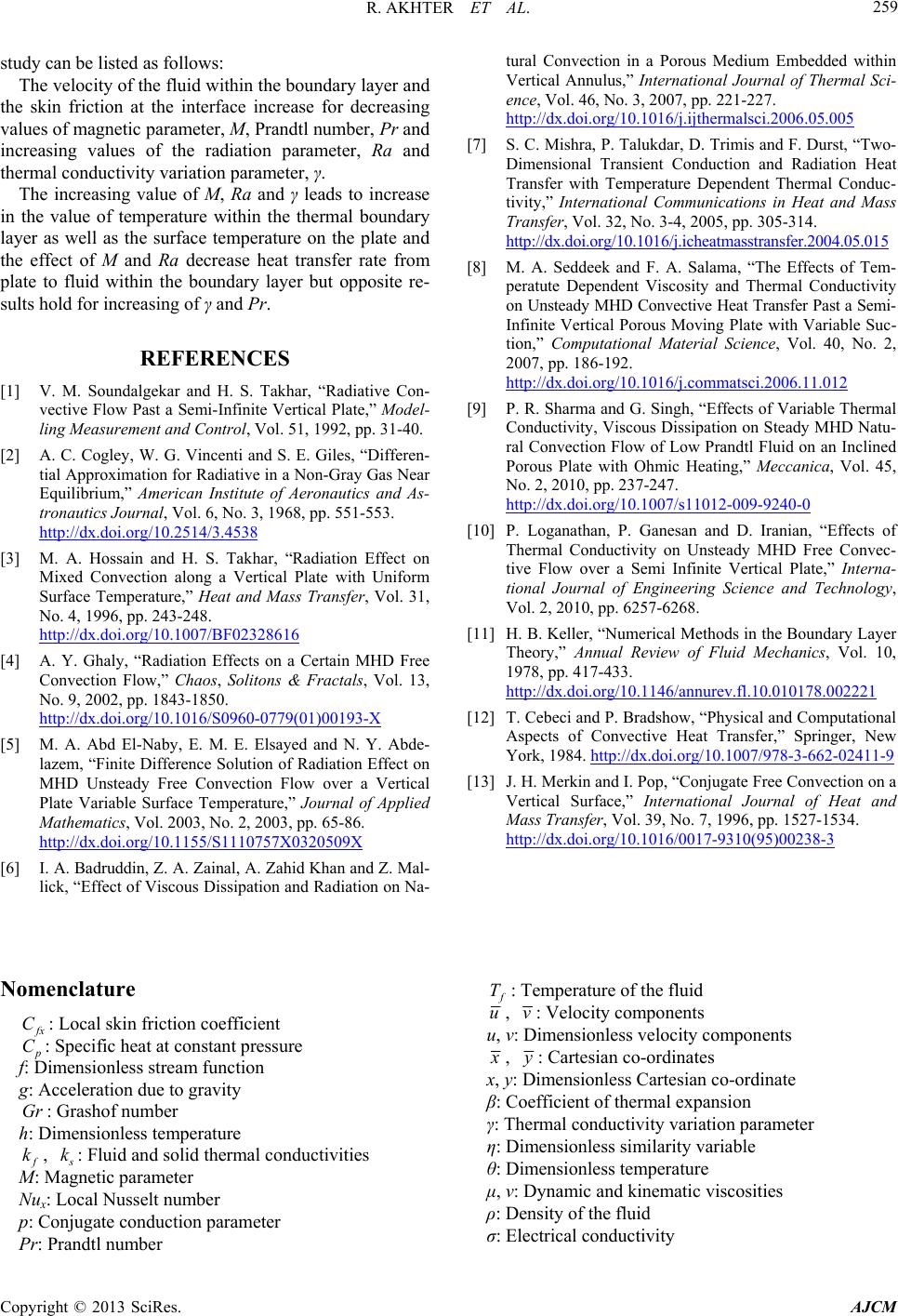
R. AKHTER ET AL.
Copyright © 2013 SciRes. AJCM
259
e for decreasing
[1] V. M. Soundalgekar and H. S. Takhar, “Radiative Con-
vective Flow Pical Plate,” Model-
ling Measurem, 1992, pp. 31-40.
tural Convection in a Porous Medium Embedded within
Vertical Annulus,” International Journal of Thermal Sci-
ence, Vol. 46, No. 3, 2007, pp. 221-227.
http://dx.doi.org/10.1016/j.ijthermalsci.2006.05.005
[7] S. C. Mishra, P. Talukdar, D. Trimis a nd F. Durst, “T
Dimensional Transient Conduction and Radiation
study can be listed as follows:
The velocity of the fluid within the boundary layer and
the skin friction at the interface increas
values of magnetic parameter, M, Prandtl number, Pr and
increasing values of the radiation parameter, Ra and
thermal conductivity variation parameter, γ.
The increasing value of M, Ra and γ leads to increase
in the value of temperature within the thermal boundary
layer as well as the surface temperature on the plate a
wo-
Heat
Transfer with Temperature Dependent Thermal Conduc-
tivity,” International Communications in Heat and Mass
Transfer, Vol. 32, No. 3-4, 2005, pp. 305-314.
http://dx.doi.org/10.1016/j.icheat ma sst ran sfer.200 4.05.01 5
[8] M. A. Seddeek and F. A. Salama, “The Effects of Tem-
peratute Dependent Viscosity and Thermal Conductivity
nd
the effect of M and Ra decrease heat transfer rate from
plate to fluid within the boundary layer but opposite re-
sults hold for increasing of γ and Pr.
REFERENCES
on Unsteady MHD Convective Heat Transfer Past a Semi-
Infinite Vertical Porous Moving Plate with Variable Suc-
tion,” Computational Material Science, Vol. 40, No. 2,
2007, pp. 186-192.
http://dx.doi.org/10.1016/j.commatsci.2006.11.012
[9] P. R. Sharma and G. Singh, “Effects of Variable Therm
Conductivity, Viscous Dissipation on Steady MHD
al
Natu-
ast a Semi-Infinite Vert
ent and Control, Vol. 51ral Convection Flow of Low Prandtl Fluid on an Inclined
Porous Plate with Ohmic Heating,” Meccanica, Vol. 45,
No. 2, 2010, pp. 237-247.
http://dx.doi.org/10.1007/s11012-009-9240-0
[10] P. Loganathan, P. Ganesan and D. Iranian, “
Thermal Conductivity on Unsteady MHD Fr
[2] A. C. Cogley, W. G. Vincenti and S. E. Giles, “Differen-
tial Approximation for Radiative in a Non-Gray Gas Near
Equilibrium,” American Institute of Aeronautics and As-
tronautics Journal, Vol. 6, No. 3, 1968, pp. 551-553.
http://dx.doi.org/10.2514/3.4538
[3] M. A. Hossain and H. S. Takhar, “Radiation Effect on
Mixed Convection along a Vertical Plate with Unifo
Surface Temperature,” Heat and Mass Transfer
Effects of
ee Convec-
Fluid Mechanics, Vol. 10,
tive Flow over a Semi Infinite Vertical Plate,” Interna-
tional Journal of Engineering Science and Technology,
Vol. 2, 2010, pp. 6257-6268.
[11] H. B. Keller, “Numerical Methods in the Boundary Layer
Theory,” Annual Review of
rm
, Vol. 31,
No. 4, 1996, pp. 243-248.
http://dx.doi.org/10.1007/BF02328616
[4] A. Y. Ghaly, “Radiation Effects on a Certain MHD Free
Convection Flow,” Chaos, Solitons &
No. 9, 2002, pp. 1843-1850.
1978, pp. 417-433.
http://dx.doi.org/10.1146/annurev.fl.10.010178.002221
[12] T. Cebeci and P. Bradshow, “Physical and Computation
Aspects of Convective Heat Transfer,” Springer, Ne
Fractals, Vol. 13,
al
w
http://dx.doi.org/10.1016/S0960-0779(01)00193-X
[5] M. A. Abd El-Naby, E. M. E. Elsayed and N. Y. Abde-
lazem, “Finite Difference Solution of Radiation Eff
MHD Unsteady Free Convection Flow over a V
York, 1984. http://dx.doi.org/10.1007/978-3-662-02411-9
[13] J. H. Merkin and I. Pop, “Conjugate Free Convection on a
Vertical Surface,” International Journal of Heat and
ect on
l ertica
Plate Variable Surface Temperature,” Journal of Applied
Mathematics, Vol. 2003, No. 2, 2003, pp. 65-86.
http://dx.doi.org/10.1155/S1110757X0320509X
[6] I. A. Badruddin, Z. A. Zainal, A. Zahid Khan and Z. Mal-
lick, “Effect of Viscous Dissipation and Radiation
Mass Transfer, Vol. 39, No. 7, 1996, pp. 1527-1534.
http://dx.doi.org/10.1016/0017-9310(95)00238-3
on Na-
Nomenclature
T: Temperature of the fluid
x
C: Local skin friction coefficient
C: Specific heat at constant pressure
imensionless stream function f: D
g: Acceleration due to gravity
Gr : Grashof number
h: Derature imensionless temp
k,
k: Fluid and solid thermal conductivities
M: Magnetic parameter
Nux: Local Nusselt number
p: Conjugate conduction parameter
Pr: Prandtl number
u, v: Velocity components
v: Dimensionless velocity cou, mponents
, : Cartesian co-ordinates
x, y: Dimensionless Cartesian co-ordinate
β:oeion
γ: Thermal conductivity variation paramete
Cfficient of thermal expansr
es
η: Dimensionless similarity variable
θ: Dimensionless temperature
μ, v: Dynamic and kinematic viscositi
ρ: Density of the fluid
σ: Electrical conductivity